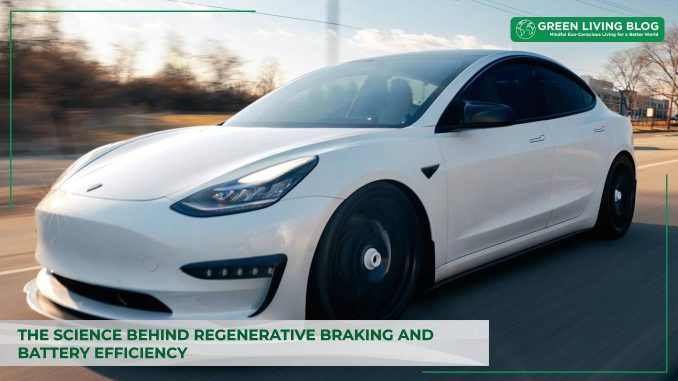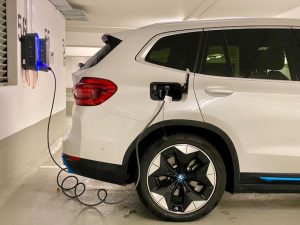
There’s a world of difference between conventional internal combustion vehicles and electric vehicles (EVs).
Despite having a shared purpose of moving people and goods, these two types of vehicles diverge in terms of power sources. It’s common knowledge that traditional vehicles use fuel to power internal combustion engines while EVs rely on batteries and electric motors.
Did you know, though, that these vehicles can also execute their braking functions differently? Hybrid and electric vehicles can use regenerative braking, an option that is not available to combustion vehicles.
What Is Regenerative Braking?

Regenerative braking is a technology that converts kinetic energy that is typically lost during braking into electrical energy. The converted energy is then stored in the vehicle’s battery for later use, and it is typically utilised to improve a hybrid or electric vehicle’s overall energy efficiency and driving range.
Vehicles with internal combustion engines do not have the capability to use regenerative braking, so if you own a fuel-powered vehicle, you might find this braking function to be a new concept. In case you’re thinking of shifting to EVs, though, you must look into regenerative braking when evaluating your options.
The capability of your vehicle to maximise regenerative braking will help you cover greater distance with your EV without increasing the level of energy that you source from your Tesla Wall installation or similar EV charger at home or in the office.
The Science Behind Regenerative Braking
Before delving into how regenerative braking works, we must first look at conventional braking systems. In such systems, applying the brakes means generating friction between the brake pad and the rotors. This interaction converts kinetic energy to heat, which then dissipates in the environment. The process effectively slows down the vehicle but wastes the kinetic energy.
Regenerative braking, on the other hand, uses the electric motor as a generator. When the driver applies the brakes or decelerates, the vehicle’s electric motor reverses its function. Instead of consuming electrical energy to generate motion, it uses the vehicle’s kinetic energy to produce electrical energy. Up to 70% of the kinetic energy can be recaptured by using regenerative braking. This generated electricity is then fed back into the vehicle’s battery and stored for future use. Let’s break down this process:
- Deceleration Initiation – The regenerative braking system engages either when the EV driver lifts their foot off the accelerator or as they apply the brake pedal.
- Motor Reversal – The electric motor switches from drive mode to generator mode.
- Energy Conversion – As the vehicle slows down, the kinetic energy is converted into electrical energy by the motor.
- Energy Storage – The generated electrical energy is transferred to the battery where it is stored for later use.
A Comparison of Conventional Braking and Regenerative Braking

A vehicle that is capable of regenerative braking offers several advantages when compared to vehicles without this function. In particular, here are some of the biggest benefits that users get to enjoy by choosing an EV with this feature:
- Energy Efficiency – Conventional braking dissipates kinetic energy as heat, wasting it. In comparison, regenerative braking recovers a portion of this energy and converts it back to electricity so that it can be stored in the battery.
- Wear and Tear – Conventional braking relies heavily on friction and leads to wear and tear of brake pads and rotors. Meanwhile, regenerative braking reduces the reliance on friction brakes and effectively extends the lifespan of brake components.
- Control Mechanism – Regenerative braking uses the electric motor’s control systems, whereas conventional braking relies on hydraulic or mechanical systems.
Regenerative Braking in EVs and Its Impact on Battery Life
Regenerative braking is deemed a critical feature for improving the efficiency and extending the driving range of electric and hybrid vehicles. By recapturing energy that would otherwise be lost during braking, EVs can travel further on a single charge. Here’s a list of how this capability can impact a vehicle’s battery life:
- Energy Recovery – Regenerative braking helps maintain the battery’s charge by recovering energy and reducing the frequency of charging cycles. This, in turn, can contribute to longer battery life.
- Thermal Management – By generating less heat compared to conventional braking, regenerative braking reduces thermal stress on the battery and associated systems, an effect that can potentially enhance battery longevity.
- Cycle Count – Modern lithium-ion batteries are designed to handle many cycles, but frequent cycling can still impact overall battery health over time. While regenerative braking helps recharge the battery, it also contributes to the battery’s charge-discharge cycles.
The regenerative braking capabilities of electric and hybrid vehicles can become a significant factor in helping consumers decide which EV or hybrid vehicle model to purchase. As you make the switch to EVs, take a close look at your options’ capability to recapture kinetic energy and turn it into electricity. Doing so will help you extend the driving range of EVs and allow you to contribute to the overall sustainability and cost-effectiveness of electric transportation in your own way.
![]()
Author Profile
- Passionate content creator, contributor, freelance writer and content marketing allrounder.
Latest entries
 Green LivingApril 17, 20254 Eco-Friendly Habits to Pair With Your Herbal Tea Ritual
Green LivingApril 17, 20254 Eco-Friendly Habits to Pair With Your Herbal Tea Ritual Best practicesApril 12, 2025Top 6 Eco-Friendly Choices for Sustainable Living in Your Everyday Life
Best practicesApril 12, 2025Top 6 Eco-Friendly Choices for Sustainable Living in Your Everyday Life BusinessMarch 31, 2025How to furnish your Office with sustainable Cardboard Furniture
BusinessMarch 31, 2025How to furnish your Office with sustainable Cardboard Furniture Best practicesMarch 21, 202511 Practical Ways to Limit Your Exposure to Microplastic Pollution
Best practicesMarch 21, 202511 Practical Ways to Limit Your Exposure to Microplastic Pollution






Leave a Reply
You must be logged in to post a comment.